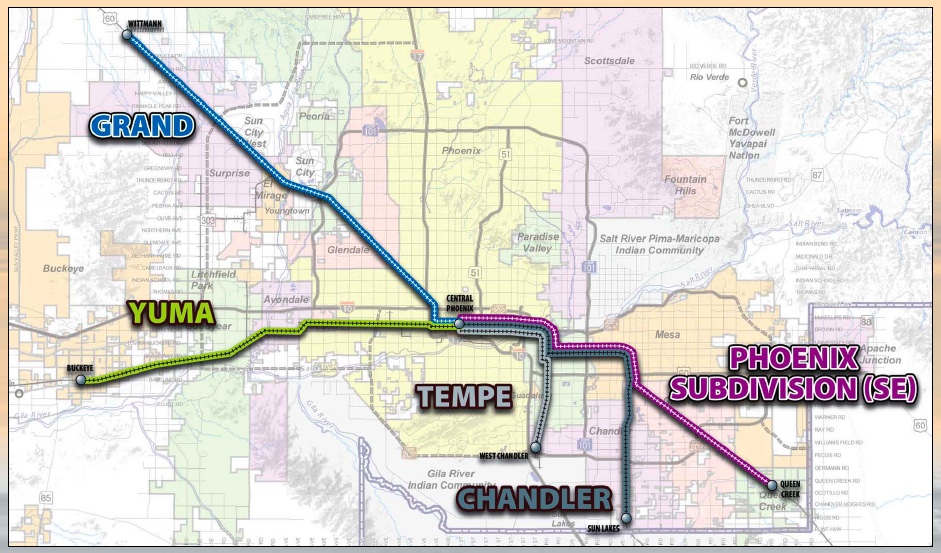 In polite cocktail party chatter, after people ask why we don’t have more solar in Arizona, they often bemoan the fact that why we don’t have a high speed rail line between Phoenix or Tucson, etc.
In polite cocktail party chatter, after people ask why we don’t have more solar in Arizona, they often bemoan the fact that why we don’t have a high speed rail line between Phoenix or Tucson, etc.
After all, there are only so many times you can get pinned between two 18-wheelers and a 20-year old in a Hummer with spinney wheels on I-10 before you start to wonder if there is isn’t better way.
The only answer I got when I asked was that there was not sufficient capacity on the rail line next to I-10 between Phoenix and Tucson.
 The issue came front and center when Amy and I were in New Mexico in October, riding that state’s spankin’ new Rail Runner between Albuquerque and Santa Fe.
The issue came front and center when Amy and I were in New Mexico in October, riding that state’s spankin’ new Rail Runner between Albuquerque and Santa Fe.
I gotta say, I was a little embarrassed that New Mexico was kicking our collective petooty in the high speed rail department. This thing was pretty swanky, in all it’s double-decker, panoramic windowed glory. Kinda like pimp my ride meets the Santa Fe Super Chief.
Well, it just so happens that one of my real estate clients helped plan and install the high speed rail servicing Washington, DC. So, he pointed me to people who could get me some answers as to why we don’t have this basic necessity and what it would take to get it.
He pointed me first to Chris Blewett, the project manager behind New Mexico’s Rail Runner. This soft-spoken public servant seemed almost underwhelmed by his own accomplishments. At a total cost of $400 million (via state bond), they had phase one of the rail line completed in about 2 years, from conception to operation. That was 45 miles of upgraded track, plus trains. Phase 2, the next 100 miles, was completed about 2 years later.
 In government time, that’s like doing the 100 meter dash in 5 seconds.
In government time, that’s like doing the 100 meter dash in 5 seconds.
So certainly, you’d think, it can’t be that bad. Absent our budget morass, we could pull that off, right? Heck, Civic Plaza cost over $500 million.
Well, the reasons it worked so easily was that there was under-used Burlington Northern Santa Fe (BNSF) line between the two cities. All the state had to do was kinda spruce it up with new ties and some new track, according to Blewett.
What made the rail line necessary, however, was not so much the traffic but the Native American communities that dot the land on either side of the existing I-25. The freeway simply can’t grow outward any further without encroaching on tribal land. This problem won’t be apparent tomorrow, but it would bottleneck the entire state in the next decade if alternatives were not created.
The rail line, on the other hand, offered an actual solution and that is where we need to learn to make better arguments.
According to Blewett, when answering the “why not here” question, you have to look more broadly. You have to answer the question: what can commuter rail help with beyond the old standard “traffic and air quality” issues?
It creates an alternative and markets like alternatives. It allows you to build affordable housing closer to work. Money put in to rail goes further per mile than money put in to widening freeways.
 If it were all that simple, then we would have it in Arizona, right?
If it were all that simple, then we would have it in Arizona, right?
That is when I turned to Mark Pearsall, a rail transit planner with the Maricopa Association of Governments (MAG). The first thing he did was clarify for me that we are really talking about two different things: commuter rail and passenger rail.
1) The commuter rail is in the metro area, it travels long distances (say from Wickenberg to Gilbert), but it makes frequent stops. It is an elevated train, so it is not light rail. But it is not a connector for major metro areas. This needs rail lines capable of speeds up to 79 miles per hour.
There are several options for commuter rail in Phoenix: BNSF owns track from Wickenberg, down Grand Ave. to Central Phoenix. A commuter could get from Surprise to downtown Phoenix is 30 minutes. (You think the wait is long at Matt’s Big Breakfast now? Just wait.)
In order to make that happen, we would have to lay parallel track on the Grand Ave. corridor, do some signal upgrades and build a few bridges. Pearsall estimates this would average 5,000 riders per day.
There is also a Union Pacific track that could connect Buckeye to Phoenix. They would actually have to lay more main-line track in that case. Finally, there is a southeast line that could connect Phoenix, Tempe, Gilbert and Queen Creek.
According to Pearsall, this entire network would move 17,000 riders per day.

This is where money is not the only problem. Have a look at the map above. In order to see all of those connections, you would have to find a way to connect a number of those track lines that are not already connected. The map makes it look easy, but it is a spaghetti junction of rules, ownership and rights of way.
Further, you’d need to get agreement from BNSF about dedicating valuable track space and time to passenger rail. While not using all of the track space now, BNSF fears that they might in the near future.
MAG is going to come out with the results of a study in the spring, the most serious in 30 years, with conclusions about which of these lines are the most feasible. Click on the photo, above to download a copy of a recent system analysis. You will be able to get the major study at the same website in the spring.
This is where it comes down to money again. The next time the existing transportation sales tax is up for renewal is 2026, and I don’t see the voters going for another tax on top of our existing one any time soon.
So, no! No twain for Chwistmas until 2026, little Johnny!
2) Passenger rail is what we think of when we talk about Phoenix to Tucson or L.A. to Phoenix.
The problems of using existing track and laying new main lines is the same as with commuter rail, but the costs for completing the projects are much higher. However, whereas you can share rail corridors between commuter and freight rail in many cases in Maricopa County, Union Pacific tells us that we would have to build our own corridor for passenger rail between Tucson and Phoenix.
That’s big money, folks.
This is where Pearsall has hope for an ADOT study, under way now. That study will identify the top 8 corridors of possible service between Phoenix and Tucson in which you could average 70 to 100 mph. This “alternatives analysis” is meant to start the discussion of getting federal dollars to lay the track.
You know, “baby steps.”
This is also where MAG and ADOT will be coordinating efforts. They will want to locate commuter rail line next to passenger rail line in some cases to maximize efficiency and make a seamless system.
Pearsall is confident that all of these details could and would be worked out once there is money in the pot. Railroads would change their tune and track could be laid.
 Just drop $2billion in the tip jar on the way out, thanks.
Just drop $2billion in the tip jar on the way out, thanks.
But, you could envision it one day. Just close your eyes and let’s imagine together: hiking in the mountains around Wickenberg, stopping off for lunch in downtown Phoenix and having a nice evening out in Tucson, without ever setting foot on a gas pedal.
Or, more seriously, you could actually save money over building new, congested freeways. (gasp!)
However you want to look at it, I think it is a goal we should have.
Postscript: It looks like the AZ Republic was doing a story on this issue as I was writing this. So, learn more here.


 Here is another redistricting and
Here is another redistricting and  In polite cocktail party chatter, after people ask why we don’t have more solar in Arizona, they often bemoan the fact that why we don’t have a high speed rail line between Phoenix or Tucson, etc.
In polite cocktail party chatter, after people ask why we don’t have more solar in Arizona, they often bemoan the fact that why we don’t have a high speed rail line between Phoenix or Tucson, etc.
 In government time, that’s like doing the 100 meter dash in 5 seconds.
In government time, that’s like doing the 100 meter dash in 5 seconds.

 Just drop $2billion in the tip jar on the way out, thanks.
Just drop $2billion in the tip jar on the way out, thanks.
 The City of Phoenix
The City of Phoenix 

 The Arizona Republic ran an
The Arizona Republic ran an  Of course, one critique of articles like that above is that there never really ever was civility in politics. As I recall, opponents of
Of course, one critique of articles like that above is that there never really ever was civility in politics. As I recall, opponents of